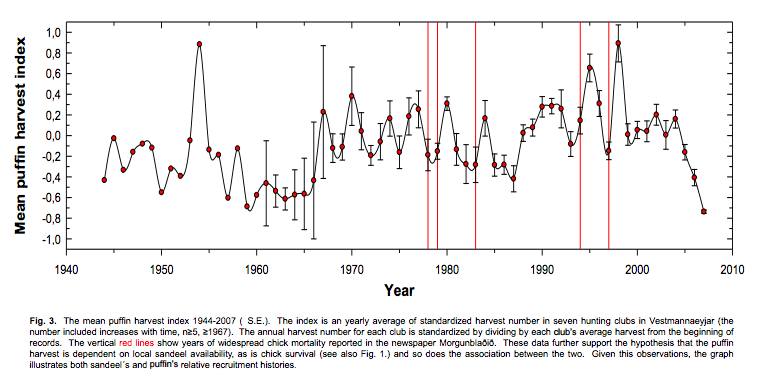Tourist Consumption of Local Species
Icelanders have been known to consume wildlife that is seen as a bit unusual to the rest of the world. Traditional meats include animals such as horses, sheep (including the entire head!), fish, shark, puffins and other seabirds, and whales. The last two in particular are the cause for some concern due to the status of wild populations of seabirds and whales.

Fish Are Friends Not Food!
Although this famous Finding Nemo quote refers to fish, it is also the opinion for many people in reference to whales. Many countries around the world have now banned whaling, at least in part, due to population level concerns (7). In Iceland whaling has been part of the culture since around the 17th century, mostly as an opportunistic harvest (2). For the most part Icelanders only consume whale meat as a specialty dish during Thorri and the rest is exported to Asian countries. However a new use for whale meat has emerged recently as a novelty food for curious tourists and therefore increasing the demand for whale meat within Iceland. A study showed that only 5% of Icelanders regularly consume whale meat opposed to an astonishing 40% of tourists who consumed it in 2001 (1). Concern for whale populations and the tension between competing whaling and whale watching industries have inspired some action to be taken to deter tourists from eating whale. The International Fund for Animal Welfare along with the Icelandic Association of Whale Watchers (IceWhale) began a campaign for “Meet Us Don’t Eat Us” to prompt tourists to eat at whale free restaurants and partake in whale watching (1). The IceWhale website uses a guilt tactic by showing statistics such as “81% of Icelanders never buy whale meat” and “80% of minke whale is trashed after killing” (3). It seems as though whaling in Iceland will continue as long as it is still economically viable, so to end whaling the demand for whale meat must decrease drastically. It is an enormous task to decrease demand for whale meat in the Asian market, however it is definitely possible to remove much of the demand locally in Iceland. Campaigns by organizations such as IceWhale are influencing tourist perceptions of this ‘novelty’ food in hopes that it will remove most of the demand for whale meat in the country.

A Preference for Puffins
A similar phenomenon is occurring with the cute little seabirds we know as puffins. These birds are also seen on the menu in tourist areas, served as a novelty ‘traditional’ food item and demand has increased in the past 10-15 years correlating to the growing number of tourists (4). Unlike whale meat, puffins are sold almost exclusively within Iceland and are mostly consumed locally, given away, or sold privately rather than being sold to the market (4).
Puffin at Westman Island’s Aquarium
“There are so many cultural traditions bound to harvesting seabirds. In the old days, it was a matter of survival. And of course it’s not like that anymore, but the tradition still carries on.” Egevang in interview with Hakai Magazine (5).
Unfortunately, these birds face a much more immediate threat than whale populations in Iceland. The Atlantic puffin that occupies Iceland is now considered near threatened or vulnerable on the IUCN Redlist (5). Of the seabirds hunted in Iceland, puffins are the largest targeted group where nearly 185,000-233,000 individuals are taken per year (4). Besides hunting, puffins face other threats to their population including decline of a major food source (sandeels) and the negative impacts of climate change (6).

Meet Them Don’t Eat Them
Traditional hunting of local species unlikely had much impact on the populations of those species in the past but today tells a different story. With the growing amount of tourists visiting Iceland comes a higher demand for local wildlife to be killed for consumption of novelty foods. In the past, a small portion of the 300,000 residents of Iceland consumed these traditional foods, compared to a large portion of the 1 million tourists who additionally consume the local wildlife in the present. This rapid change in demand for wildlife for food is bound to have some ecological impacts, if not noticeable yet it will be in the future.

So my advice to tourists visiting Iceland or anywhere wanting to try the local cuisine I say: Think before you eat!
Sources Cited
- McGaurr, Lyn. “The (travel Journalism) Environment.” Environmental Communication and Travel Journalism: Consumerism, Conflict and Concern. London and New York: Routledge Taylor and Francis Group, 2015. 178-82.
- Bertulli, Chiara G., Ruth H. Leeney, Thomas Barreau, and Danilo Swann Matassa. “Can Whale-watching and Whaling Co-exist? Tourist Perceptions in Iceland.” Journal of the Marine Biological Association of the United Kingdom 96.04 (2014): 969-77.
- “Iceland Whale Watching Tour Operators.” Ice Whale. Web. <http://icewhale.is/>.
- Tycho Anker-Nilssen, Vidar Bakken, John Chardine, Tom Christensen, Lynn Denlinger, Alexander Golovkin, Martti Haria, Aevar Petersen, and Kenton Wohl. “Seabird Harvest Regimes in the Circumpolar Nations.” Conservation of Arctic Flora and Fauna (CAFF). Circumpolar Seabird Working Group (CSWG), 2001. <https://oaarchive.arctic-council.org/bitstream/handle/11374/171/Seabird_Harvest_Regimes_Circumpolar_Nations_CBird_2001.pdf?sequence=1&isAllowed=y>
- Katz, Cheryl. “Disappearing Puffins Bring an Icelandic Hunting Tradition Under Scrutiny.”Smithsonian.com. Smithsonian Institution, 17 Jan. 2017. Web. <http://www.smithsonianmag.com/science-nature/uncertain-future-puffin-dinner-180961829/>.
- Hansen, Erpur S., Valur Bogason, Kristján Egilsson, Arnþór Garðarsson, Páll M. Jónsson, Kristján Lilliendahl, Ævar Petersen, Ingvar A. Sigurðsson, and Óskar J. Sigurðsson. “The Effects of Sandeel Availability, Puffin Harvest and Climate Change on the Vestmannaeyjar Atlantic Puffin Population.” (n.d.): n. pag. Univ. of Iceland, Reykjavik Iceland, Natural Sciences Conference, South Iceland Nature Research Centre, Mar. 2008. Web. <https://www.researchgate.net/publication/313853001_The_Effects_of_Sandeel_Availability_Puffin_Harvest_and_Climate_Change_on_the_Vestmannaeyjar_Atlantic_Puffin_Population?channel=doi&linkId=58ab35e1aca27206d9bd0f16&showFulltext=true>.
- “Status of Whales.” International Whaling Commission, n.d. Web. <https://iwc.int/status#species>.